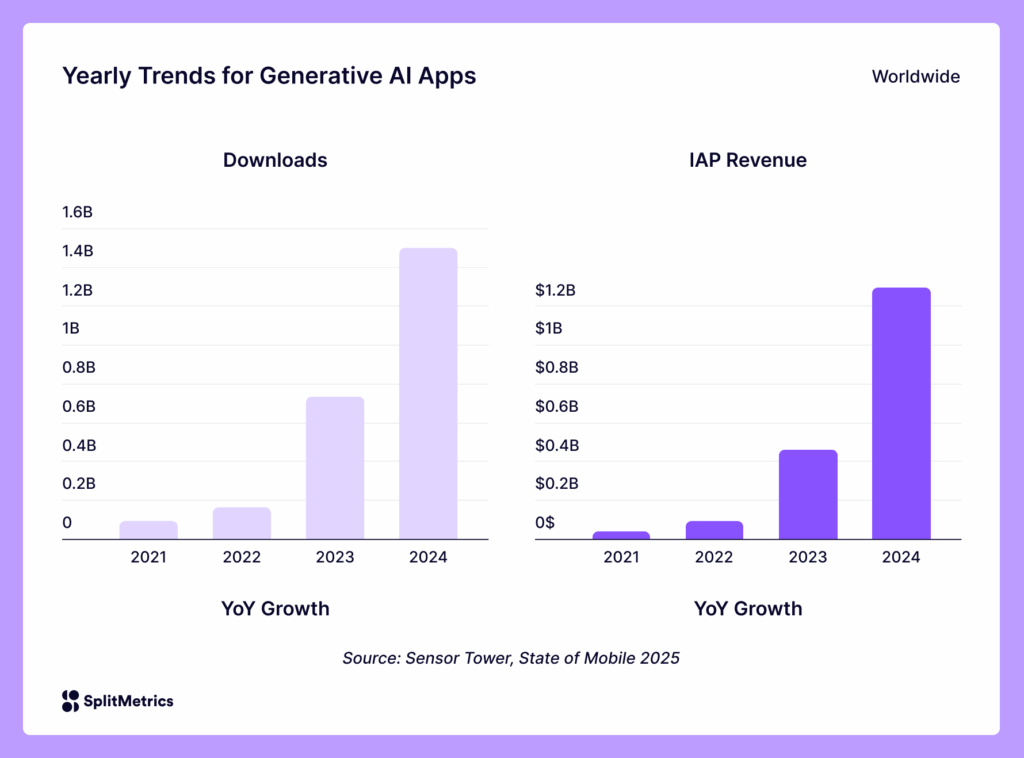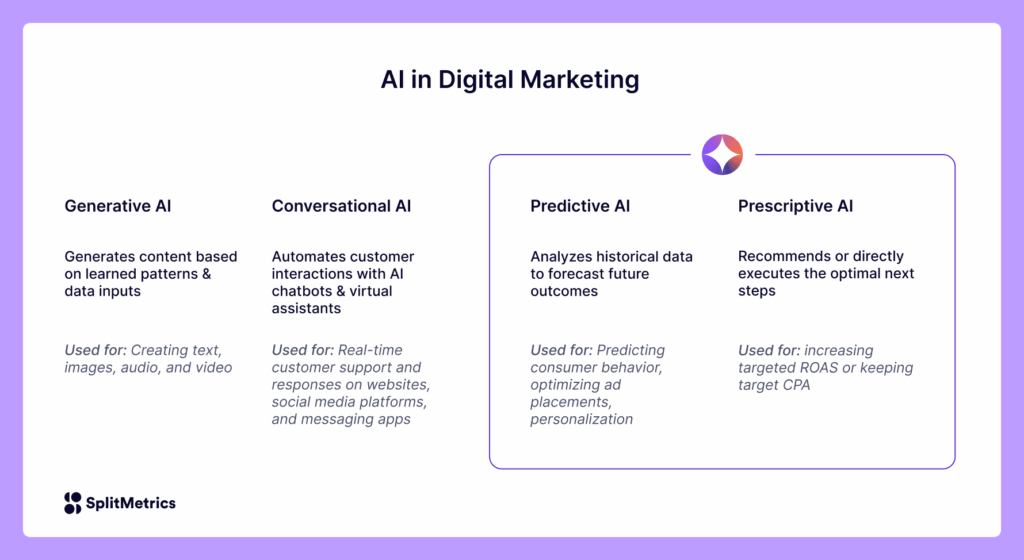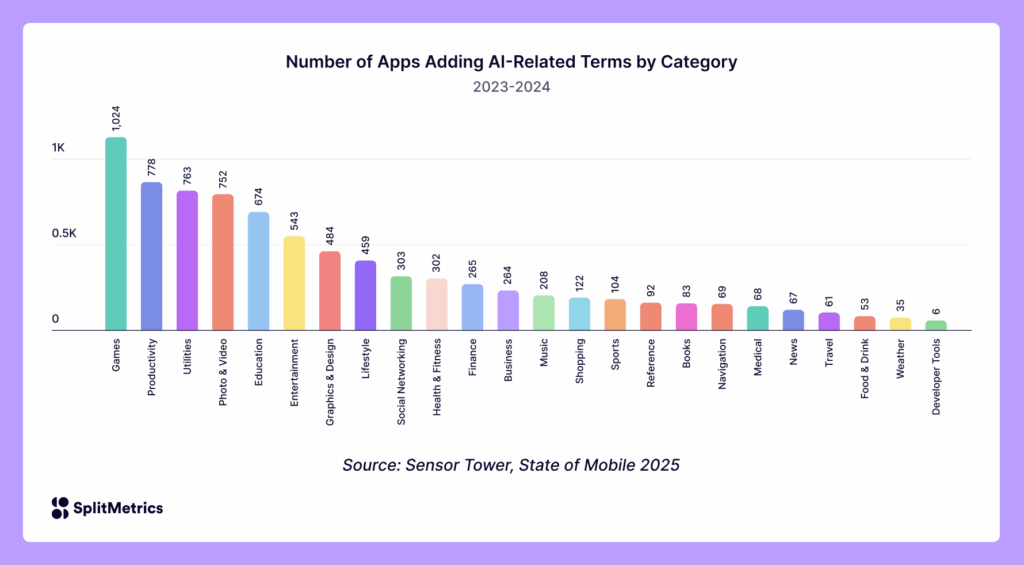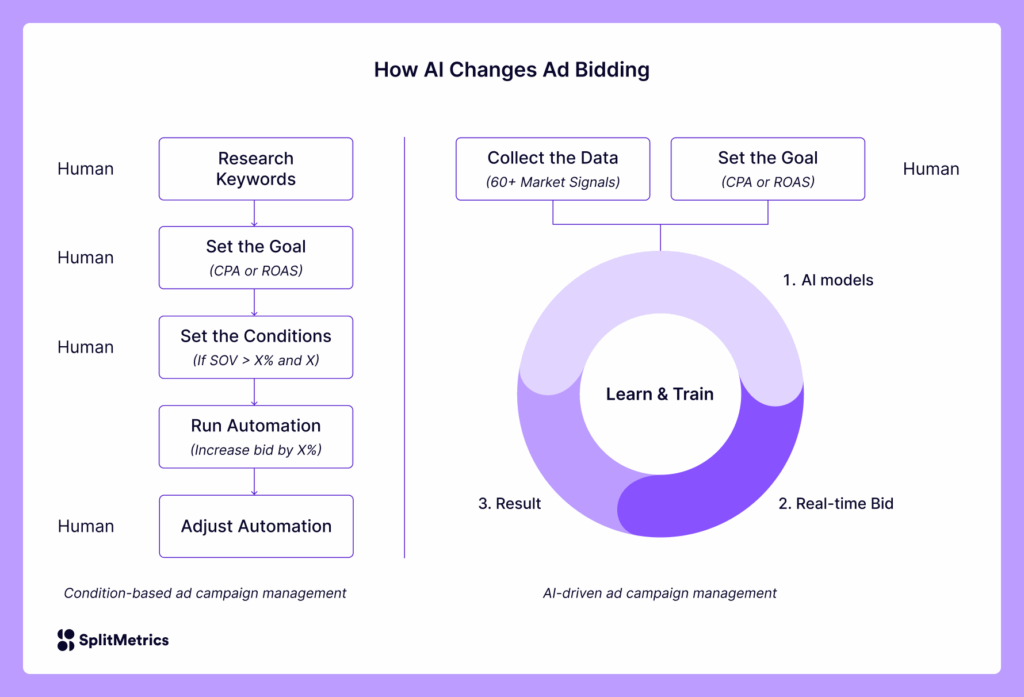For app marketers, Artificial Intelligence (AI) promises hyper-personalized campaigns and unprecedented efficiency. But beyond the buzzwords, a crucial question remains – how does AI move the needle in app marketing, and how can it be improved without giving in to the AI complexity?
AI in app marketing leverages intelligent tech to optimize user acquisition, ASO, personalized journeys, and automating campaigns for profitable app growth. And understanding how different AI types can support your app business is the first step to benefiting from AI.
Some excel at generating texts and graphics for app store listings, while others can do much more, such as predicting paid campaign outcomes and specifying exact actions that will improve your app’s performance.
This article will show you how different AI types can fuel app growth. For the last few years, we have been actively using these types to develop our own family of AI models at SplitMetrics’ R&D center. We use these models daily to help app marketers improve their KPIs like CPA and ROAS.
As the first article in the series, today, we decode four big AI types that apps should work with: Generative, Conversational, Predictive, and Prescriptive.
Before we continue with AI types, it is important to highlight that AI is shaping the app market just like many others and the data confirms it.
According to SensorTower, apps mentioning AI in their store listings accounted for 17 billion downloads in 2024, representing approximately 13% of all app downloads globally.
The same report states that downloads for Generative AI apps surged globally, approaching 1.5 billion in 2024, a 92% increase compared to the previous year.

There are also apps such as Duolingo, whose CEO, Luis von Ahn, explicitly framed the company’s strategy shift around AI, comparing it to their earlier successful bet on mobile.
And the research findings from established sources show that AI is an integral part of everyday business, but not without challenges:
The breadth of AI terminology (autonomous AI, deep learning, reinforcement learning, ANI, AGI, etc.) can also be paralyzing. It creates confusion about where to focus your attention and resources, especially if you are a mobile-first business.

Cutting through the terminological mess requires a focus on core functions. While definitions vary, the four AI types explored here offer a practical framework for app marketers.
Let’s dive into what each of these does and, more importantly, how you can put them to work for your app.
If there’s one type of AI that has captured mainstream attention since 2022, it’s Generative AI. You’ve likely interacted with tools like ChatGPT, Perplexity, Midjourney, or DALL-E.
At its core, Generative AI focuses on creating new content — text, images, code, audio, video — based on the vast amounts of data and patterns it has learned during its training. When given a prompt, it generates a response designed to match the request.
For many apps positioning themselves as “AI-driven,” Generative AI is the foundational technology to accelerate feature innovation and expand capabilities they deliver to their users.

For app marketers facing relentless demands for fresh content and creative assets, Generative AI offers compelling ways to boost efficiency and overcome common bottlenecks. Here’s how you can leverage it today:
While powerful for scaling content creation, it’s vital to understand where Generative AI falls short. Because it operates based on learned patterns rather than genuine understanding or creativity, it often struggles with the following aspects:
Next up is Conversational AI, a specialist focused on streamlining communication flows.
This AI category powers the chatbots and virtual assistants you increasingly encounter. It specializes in automating interactions by understanding and responding to human language in real-time. For instance, companies like Intercom use Conversational AI in their customer support bots and interactive FAQs.
Conversational AI can efficiently handle routine interactions, freeing up your team for more complex tasks:
The role of Conversational AI in app marketing is limited — while it has its purpose, it can help you with the operating environment that supports your app but not much with user acquisition.
Conversational AI is generally great at structured, predictable interactions. But it often struggles with highly complex, novel, or emotionally charged support scenarios where human empathy and nuanced understanding are required. Fully automating tasks like review responses across different languages and cultures is still not possible.
Its performance is highly dependent on the quality of its training data and the design of its conversational flows.
Predictive AI offers a glimpse into the future. It understands data to identify patterns, gain insights, and forecast future outcomes.
This AI type analyzes historical data not merely to understand past performance, but to forecast future outcomes. It excels at identifying subtle patterns and correlations to anticipate future events, such as user behavior, churn likelihood, campaign performance, or lifetime value changes.
This is something that app businesses can expect to do already today:
Predictive AI doesn’t come without limitations. Its effectiveness relies on several factors:
Moving beyond understanding the past and forecasting the future (Predictive AI), we arrive at Prescriptive AI, which focuses on determining and often executing the best course of action.
Prescriptive AI builds upon predictive models. It doesn’t just tell you what might happen; it analyzes potential actions and recommends or directly executes the optimal next steps needed to achieve specific goals.
It aims to answer the critical question: “Given the prediction, what should we do now?”
In the context of the app business, Prescriptive AI automates complex decision-making and aligns actions directly with performance goals.
There are also a couple of powerful use cases of Prescriptive AI for app businesses.
Just like other AI types, Prescriptive AI also comes with limitations:
The power of Prescriptive AI lies in its ability to close the loop between insight and action. This is where decision-making moves from dashboards and manual analysis towards more intelligent, automated action systems. It builds the foundation for “agentic AI,” where systems can more autonomously manage complex tasks based on high-level objectives.
Understanding the individual types of AI is crucial, but the real leverage in app marketing comes from viewing AI not as a replacement, but as an incredibly powerful toolbox.
It’s about balancing these different capabilities within a human-led strategy.
AI, particularly Prescriptive and Predictive types, is a force multiplier. It can automate complex analyses, process data faster than humans, optimize campaigns 24/7, and handle repetitive tasks tirelessly.
However, as our experience shows, AI can lack strategic intuition, deep brand understanding, ethical judgment, and the ability to make nuanced trade-offs based on long-term goals or volatile market context.
A good way of thinking about AI and human synergy is the example of chess. AI excels at calculation depth, tactical precision, and spotting patterns across millions of games (data). Humans excel at strategic planning, understanding opponent psychology (market context), intuition, adapting to novel situations, and asking the right questions. The synergy: Grandmaster + AI beats AI alone and human alone. AI suggests powerful moves. Humans validate them strategically and guide the overall game plan. Over the years, AI has influenced how humans play chess by revealing new viable strategies.
This is why your app marketing expertise remains non-negotiable. You guide the AI, set the strategic direction, interpret the outputs within the broader market context, and make the final critical decisions.
At SplitMetrics, we’ve found the most effective model combines three core pillars:
Our proprietary Samba and the AI Models Family rely on the following methodology:

The result is automated and continuously optimized campaigns designed to hit ambitious client goals like target ROAS or CPA.
As the line between automated intelligence and strategic execution continues to blur, the winners in app marketing will be those who master its orchestration with AI. The tools for execution are widely available and it is the right time to grab the opportunities.
To achieve those, start with applying the right AI – Generative for scaling content, Conversational for automating engagement, Predictive for informing strategy, and Prescriptive for optimizing actions towards your goals.